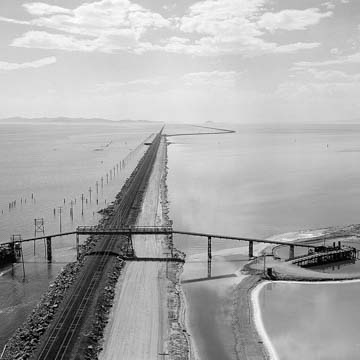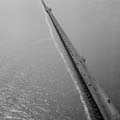When Edward H. Harriman took control of the Southern Pacific Railroad in 1901, he initiated an improvement campaign that included the construction of the Lucin Cutoff, a 102-mile-long railroad line connecting Ogden and Lucin. The existing run connecting the two northern Utah cities was among the least efficient parts of the First Transcontinental Railroad line, and involved a 1,515-foot winding climb over Promontory Point, north of Great Salt Lake. The Lucin Cutoff was built to bypass this portion, reducing curvature and grade changes in the line in order to increase speed and efficiency. Its most prominent feature was a 12-mile railroad trestle across Great Salt Lake.
The project was a huge logistical challenge. Beginning in August 1902, 3,000 men worked under the direction of chief engineer William Hood to build the crossing. The time-tested structural technology of wood trestles, when applied to an untested scale, required new building systems. Engineers developed special pile drivers that could drive piles into the lake bottom. Special boats with gas engines shipped in from San Francisco were required to complete the construction. Electric lighting illuminated Great Salt Lake as laborers worked twenty-fours a day, seven days a week. Five hundred thousand gallons of water from Deeth, Nevada, was supplied daily for the locomotives, pile drivers, and steam shovels. Four hundred side-dump cars transported 7.8 million cubic yards of dirt and stone for grading, and 38,256 trees (equating a two-square-mile forest) were felled for the 16-foot-wide trestle. A 12-mile-long temporary trestle was built in order to dump fill into the lake in order to stabilize the foundation of the main trestle. Workers drove five piles every 15 feet, which were driven crosswise to the track and fastened together with 4- to 8-inch timbers. Eighteen-foot-long beams measuring a foot square were placed above the piles; these beams were connected to the next set of piles via 11 stringers (timbers) laid lengthwise along the track. Above the stringers, a 3-inch-thick plank floor coated in asphalt formed the base of the rails. Ties and rails were then laid upon a foot or more of rock ballast. All this material, environmental mining, and labor yielded a bridge with a single track and sidings at mid-lake for passing trains.
The laborers completing this work were largely non-English speaking immigrants, who were poorly compensated and had little rights. Forty-four fatalities were recorded on the project, and the labor identification system often undercalculated pay. Workers were registered as numbers, not by their names. A number of temporary worker camps were built along the route. Once the trestle was completed, Camp No. 23 became the town of Midlake. It was built on a 240 x 40–foot platform and had a train order station, maintenance facility, and a row of houses for the crew and their families. All the supplies for this small town were brought in daily by train, including fresh water. Today all that remains is the platform, 15 feet above the high water level.
The first freight train crossed the Cutoff on March 8, 1904. The tracks did not perform well, sinking considerably as the Cutoff settled over the next few months. More fill was required to stabilize the track; it was another six months before passenger trains could travel over it. Even then the Cutoff continued to demand resources. Between 1920 and 1927 the trestle deck was replaced and additional bracing built. In 1932 two additional piles were added to each bay to stabilize the trestle, and 2,038 bracing piles were also added. Workers replenished the rock and earth fill of the foundations throughout the life of the Cutoff. After fifty years, investors were exhausted. The “permanent” bridge was deemed too costly to maintain, and plans were begun for a new earth-filled causeway to be built parallel to the old trestle bridge, 1,500 feet to the north. By 1959 the new causeway was opened for traffic. One train a week continued to cross the old trestle bridge to prevent rusting until 1970, when it was permanently closed. It was listed on the National Register of Historic Places in 1972.
In 1993, an Idaho construction firm purchased rights to the Cutoff and has been salvaging, remanufacturing, and marketing the wood from the trestle ever since.






